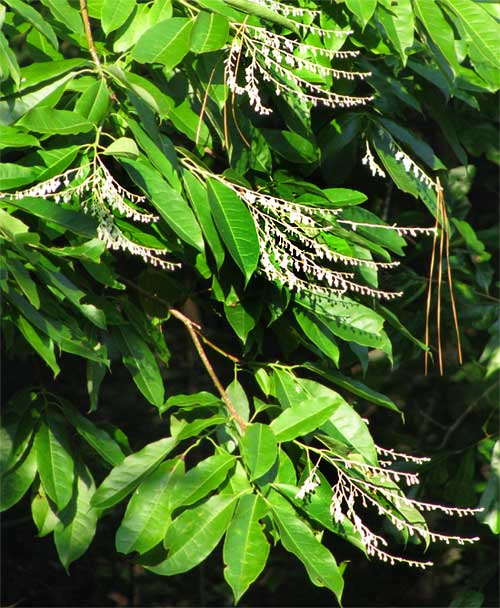Excerpts from Jim Conrad's
Naturalist Newsletter
from the June 9, 2008 Newsletter, issued from the forest near Natchez, Mississippi; elevation ~400ft (120m), ~N31.47°, ~W91.29°:
SOURWOODS FLOWERING
Probably the most interesting and conspicuously flowering tree at Pipes Lake {~N31.38°, ~W91.16°, elev. ~140ft (~40m)} was the Sourwood, OXYDENDRUM ARBOREUM, a member of the Heath or Azalea Family, the Ericaceae. You can see a 30-ft-tall Sourwood's drooping bough prettily adorned with little white flowers arranged in drooping terminal panicles below:

The leaves at first glance are nondescript, like peach or tupelo leaves. However, they have two distinctive features making them easy to identify. First, the yellowish midrib on the leaf's lower surface is equipped with stiffly erect, slender, sharp, scattered but easily seen hairs. Leaf-hairs on most other leaves are softer and shorter, and lean against the leaf surface. Second, if you chew the leaves, they'll be sour! They taste like wood sorrel or Oxalis, so they must contain oxalic acid.
The Sourwood's 1/3-inch-long flowers are elegant little upside-down goblet-like things, as you can see below:

These flowers are somewhat similar to blueberry flowers, which is OK, since they're in the same family. However, genetic sequencing indicates that within the Heath Family the Sourwood genus Oxydendrum has no close relatives. In fact, Oxydendrum is "monotypic," which means that it's a genus containing just one species, our Sourwood.
Back in Kentucky I usually found Sourwood on thin, acidic soil, especially atop sandstone ledges. At Pipes Lake it grows in thick loess (ice-age, wind-deposited dust) which is somewhat calcareous in nature and thus not acidic. Is this possibly a different subspecies, or are there connections between the two soil types I don't know about?
Sourwoods are mostly southeastern trees, occurring from Pennsylvania to western Kentucky, south to Louisiana and western Florida.